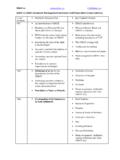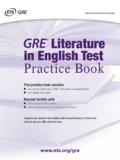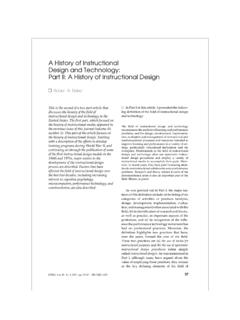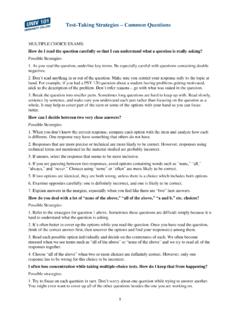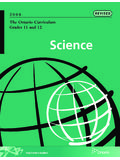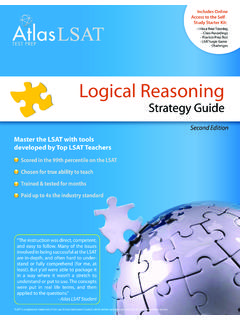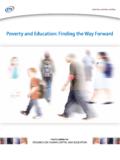Transcription of Twelve Assignments Every Middle School Student …
1 Twelve Assignments Every Middle School Student Should Write Plus Prompts for Daily Writing &. Guide for Surviving the Research Paper Gary Chadwell Copyright 2009 by Collins Education Associates LLC. All rights reserved. Twelve Assignments Every Middle School Student Should Write is a revised and expanded version of Middle School Writing Projects: Ideas for Writing Across the Curriculum originally published in 1996. The purchase of this guide entitles the individual teacher to reproduce the Assignments , Worksheets, Focus Sheets, and Tip Sheets in Chapter Three, Chapter Four, and Chapter Five for classroom use but does not permit reproduction in any part for an entire School , district or system, or for commercial use. With the exception of the Assignments in Chapters Three, Four, and Five and the graphic organizers that accompany them, no part of this publication may be reproduced or transmitted in any form or by any means, electronic or mechanical, including photocopy, recording, or information storage and retrieval system, without permission in writing from the author.
2 All reproducible pages are designated with this icon: For information about the products, workshops, and consulting services available from Collins Education Associates LLC (CEA), call us at 1-800-932-4477, visit our website at , or contact us at 320 Main Street, Box 957, West Newbury, Massachusetts 01985. ISBN: 978 0 9822965 1 6. 1 2 3 4 5 6 7 8 9 0 ITP: 5,000. August 2009. Contents Foreword by John Collins v Introduction vi Chapter 1 Writing to Learn Developing Fluency and Increasing Academic Engagement 1. Chapter 2 Learning to Write An Introduction to Key Writing Assignments 16. Seven Elements of a Great Writing Project 18. Why These Assignments Are Important 19. Worksheet for Creating Seven-Element Assignments 22. Overview of Assignments 24. Notes on Differentiating for Your students 25. Chapter 3 Essential Writing Assignments 33. The Ten Percent Summary 34. Personal Vocabulary Cards 41. Comparing and Contrasting to Clarify a Misunderstanding 47.
3 Taking a Stand 52. Chapter 4 Highly Recommended Writing Assignments 58. Writing a Personal Essay 59. Summarizing Important Information 64. Advice from a Middle School Expert: A How-To Guide 69. Collecting and Interpreting Data 72. Describing a Special Place 77. News with a View 82. Creating a Multimedia Presentation 86. Presenting a Mini-Portfolio to Next Year's Teacher 91. Chapter 5 The Guided Research Paper: Interconnected Writing Assignments 95. FAQ About the Guided Research Paper 99. assignment #1: The Persuasive Essay 103. assignment #2: Creating the Works Cited Section 107. assignment #3: The Research Essay 109. assignment #4: Revising the Introduction 114. assignment #5: Revising the Conclusion 119. Additional Resources 125. Page iii Foreword In my book, The Collins Writing Program: Improving Student Performance Through Writing and Thinking Across the Curriculum, I introduced ideas that make writing instruction more focused and manageable for teachers in all content areas.
4 Along with a rationale and research base for the program, I included many specific prompts and writing Assignments . This book, by my colleague Gary Chadwell, is meant to complement and extend those suggestions by putting a specific focus on the needs of Middle School students and their teachers. Twelve Assignments Every Middle School Student Should Write is a revision and expansion of Gary's earlier book, Middle School Writing Projects: Ideas for Writing Across the Curriculum. With this book, Gary has offered a roadmap for both using writing and teaching writing in the Middle School . In Chapter 1, he has suggested a wealth of Type One and Type Two Writing prompts that are organized by different disciplines and levels of Bloom's Revised Taxonomy of Educational Objectives. In Chapters Three and Four he has laid out a series of rich and challenging Type Four writing Assignments . As I did in The Collins Writing Program: Improving Student Performance, he has categorized these Assignments as Essential and Highly Recommended.
5 The four Essential Assignments here parallel those in my book, though they have been tailored specifically to the needs of Middle School writers. The eight Highly Recommended Assignments offer a set of unique and highly valuable Assignments that will benefit Middle School students in all content areas. A. special emphasis is placed on the kind of Assignments that are often required on state assessments including personal essays and persuasive writing. Chapter Five details strategies for making the experience of writing a research paper more manageable and enjoyable for students and teachers alike. By adapting the segmented approach from one of my earlier books, A Survivor's Guide to the Research Paper, Gary offers Assignments and resources aimed specifically at the needs of Middle School writers. This approach has a nearly two decade history of success in helping students with the challenge of writing a research paper. This book is accompanied by electronic files of reproducible pages of the book.
6 These files allow you to reproduce the Assignments and graphic organizers, to download and use them in your classroom, and to customize them for your specific classroom needs. All reproducible pages available on the CD are designated with this icon: John J. Collins, CEO, Collins Education Associates LLC. Page v Introduction For years writing across the curriculum has been a topic of discussion and often the subject of inservice sessions. Yet for most schools, infusing more writing into content areas was more of a worthy goal than a schoolwide priority. Today, however, writing across the curriculum has become a priority and a high-stakes enterprise because of the increased emphasis given writing by statewide assessment programs. These assessment programs are causing educators across the country to reassess their approach to teaching and using writing. Today, virtually Every state uses Student writing as part of its assessment program. Most states use the assessment for the primary purpose of improving instruction, but the assessment programs are used for other reasons, too.
7 They are used for School accreditation, high School graduation, endorsed diplomas, teacher evaluation, and, in some cases, state funding. The burden for preparing students for these assessments should not fall to English teachers alone. Most of the statewide assessment programs now require constructed responses (brief explanations of reasoning or support for an answer) in social studies, mathematics, and science. The implication for educators is clear: Use writing in your coursework because students who are not comfortable writing about their content learning will be ill-prepared for the challenges they face on the tests. This point was underscored for me by a district science curriculum coordinator whom I have worked with closely for several years. The coordinator was working with his state's pilot of its new science assessment program. In that assessment, twenty percent of the test involved constructed response questions. The pilot coordinators were alarmed by the number of students who simply skipped the constructed response questions.
8 These same students answered the multiple choice questions, but when they were asked to explain answers, critique scientific investigations, or describe steps in a process they opted to not even try. My friend held the same theory as I did about why so many students were reluctant to answer the constructed responses: They were intimidated by the task. These questions required only a few sentences to answer not a full-blown essay. But because they were unaccustomed to writing about science concepts, the questions seemed daunting. Page vi Intr oduction The surest way to help students overcome their discomfort with writing in any content area is to have them write on a regular basis about their learning. This book offers practical and manageable ways for you to infuse more writing into coursework and help your students become more fluent with their writing. The specific ideas contained here are inspired by the strategies described by Dr. John Collins in his book, The Collins Writing Program: Improving Student Performance Through Writing and Thinking Across the Curriculum.
9 I have written this book as a companion piece to Collins's book; I offer it as a ready-to-use, daily resource for Middle School teachers using the Collins Writing Program. The ideas and strategies I describe are designed for use by Middle School teachers in all content areas. The first chapter, Writing to Learn Developing Fluency and Increasing Academic Engagement, suggests a broad range of prompts and thought- provoking questions that not only help teachers teach but also help students become comfortable with getting their ideas into writing. The second chapter, Learning to Write An Introduction to Key Writing Assignments , serves as an introduction to what the book title promises Assignments that Every Middle School Student should be doing. The final three chapters describe more formal writing Assignments for students that provide an opportunity to develop and sharpen specific thinking and writing skills. In the early years of the No Child Left Behind era of testing and accountability, eighth grade was typically a target grade for much of the assessment.
10 Some educators mistakenly saw this as a special burden of test preparation for the unlucky eighth- grade teachers. Now, however, the statewide assessments have been spread over more grades and disciplines so that few teachers can realistically feel they are not key players in preparing their students for the high-stakes assessments. All Middle School teachers, in all disciplines, must be involved in preparing students to think and write. We must change the culture of our classrooms so that writing is an integral part of the teaching and learning process in all subject areas. But don't mistake this book for a test-preparation guide. The strategies and ideas here go well beyond preparing Middle School students for writing assessments. They are consistent with the most frequent recommendations being made today for effective teaching. Over the last few years, there has evolved a growing consensus of state-of-the-art practices best practices in each curriculum area.

